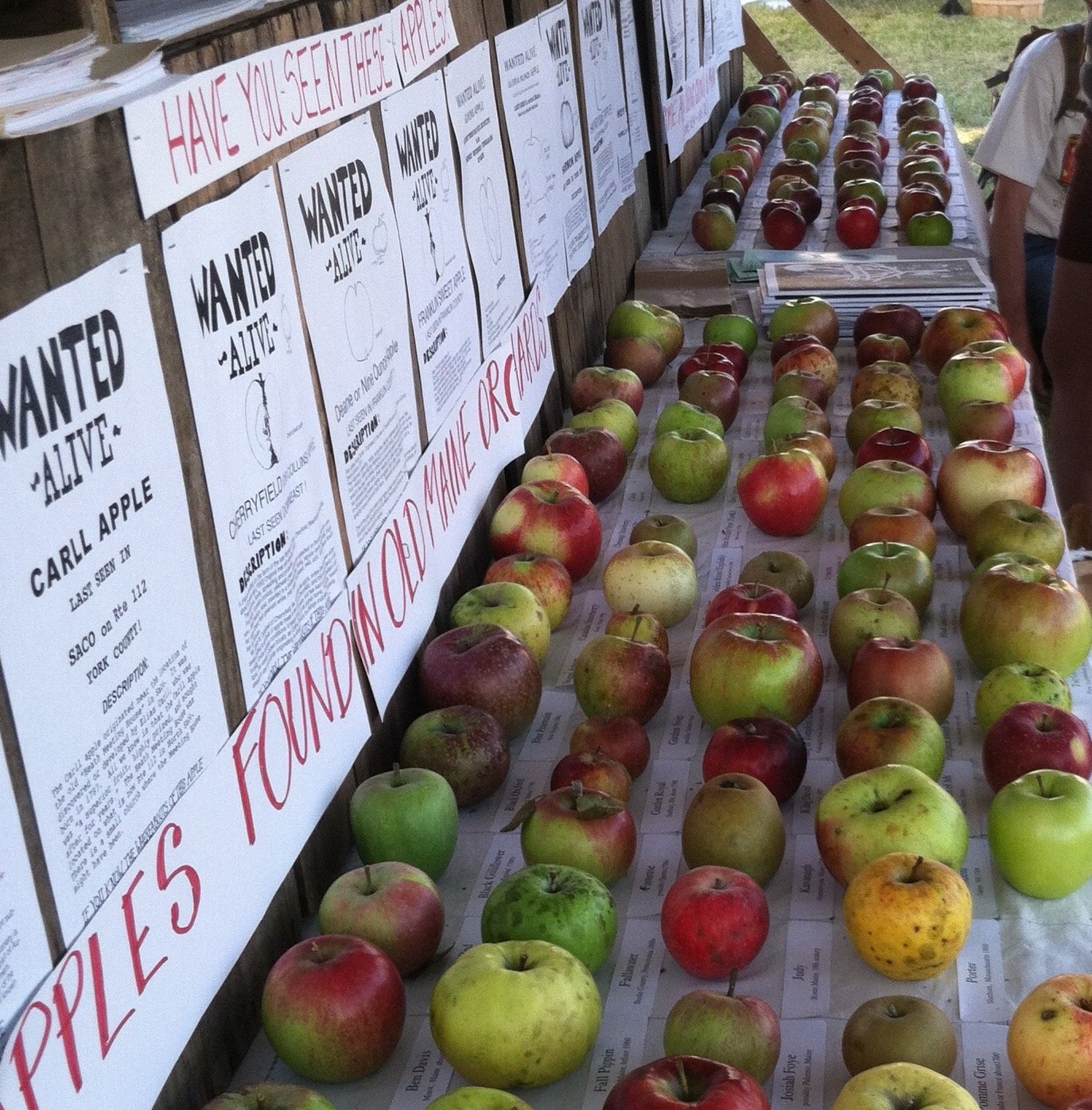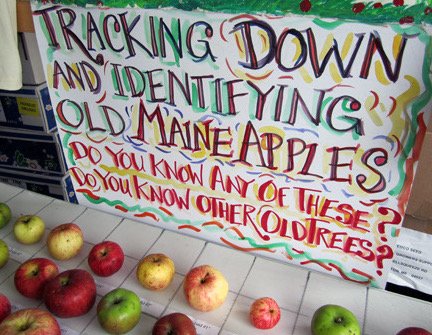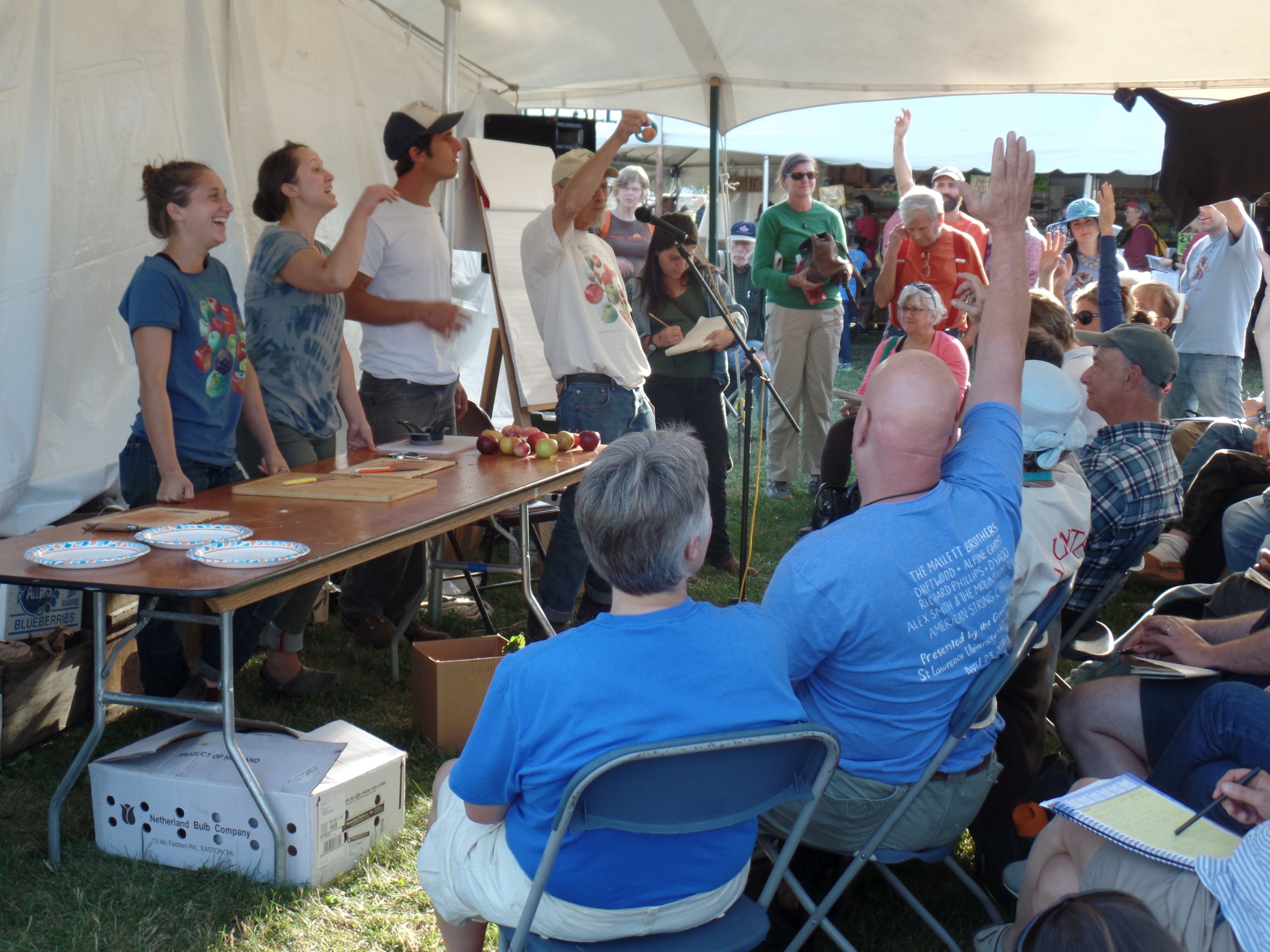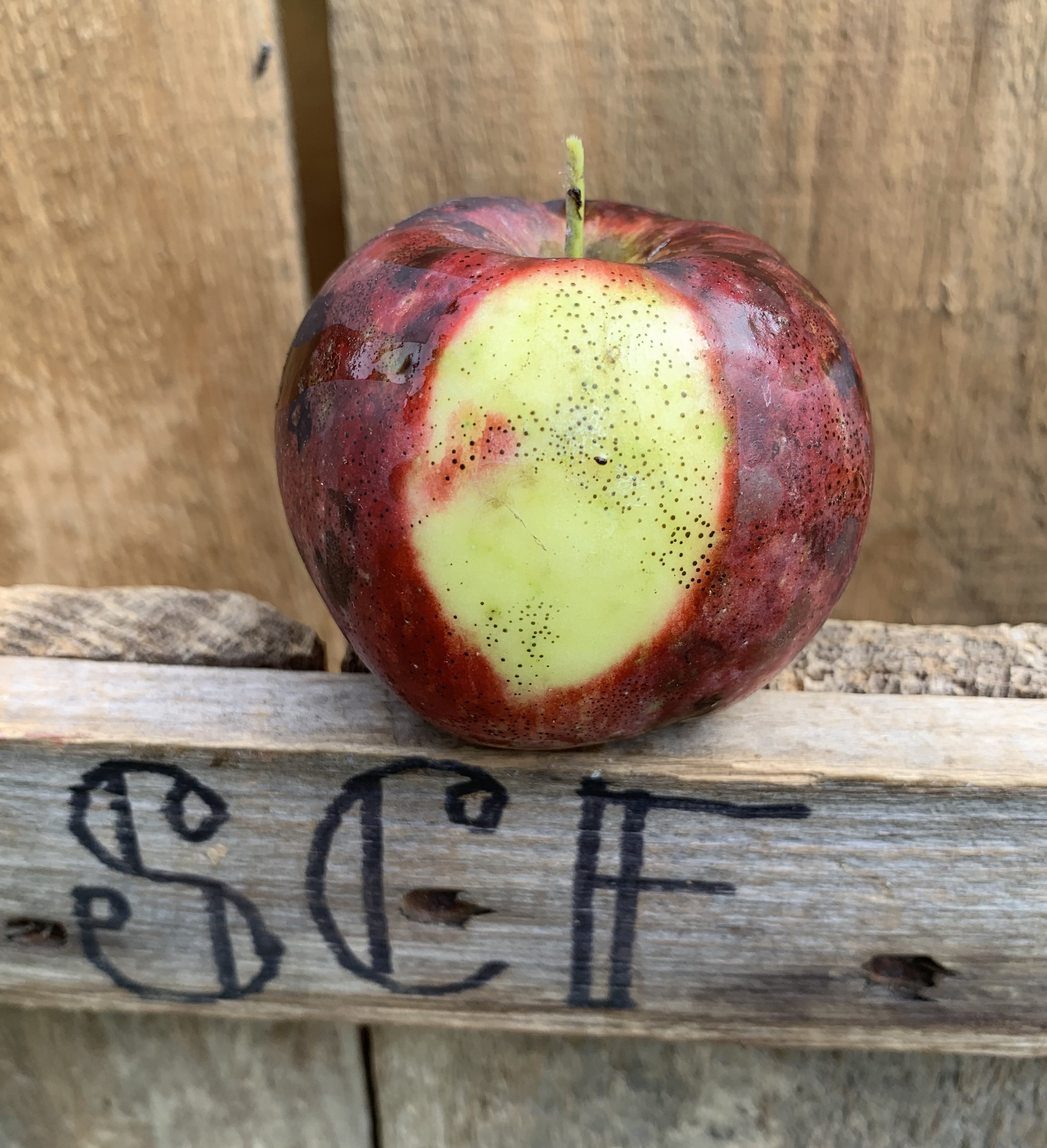This year’s CSA week #2 is also the lead up to the Common Ground Country Fair in Unity. While we’re out in the orchards picking apples to pack up for you, we’re also collecting dozens of varieties for the gigantic Fair apple display as well as for the daily apple tastings. The tastings and the display are always at the Hayloft Tent which is the place to be for everyone who loves apples. It’s staffed all weekend by a friendly, rag-tag bunch of apple geeks who love to talk shop and identify apples.
The Fair has been good to us over the years. Without it there might not be an Out on a Limb CSA, a Maine Heritage Orchard, or even a Fedco Trees. John met most of his apple mentors at the Fair, each of whom introduced him to new varieties and taught him the tricks of the trade. Back when the Fair was in Windsor, Mercer orchardist Francis Fenton used to come to the Fair and set up a display on a tilted placard of plywood. He stuck nails through the wood and stabbed twenty or thirty apples onto the nails. Francis loved to talk about apples, and the Fair gave him the perfect opportunity to do so. It was Francis Fenton’s funky plywood that inspired the first display John put together for the Fedco Tent several years later. John and Francis became close friends, and Francis introduced John to many of the apples that formed the foundation of the Maine Heritage Orchard and are mainstays of the CSA.
As John discovered more varieties, the Fair display expanded as well. It became a magnet for young and old who came to gawk at apples of all colors, shapes and sizes. One year it won the best display of the Fair. Sometimes there were also smaller themed displays, such as a history of McIntosh or the mystery of the Pumpkin Sweet apple that included half a dozen apples from around the state all known locally as Pumpkin Sweet and all quite different from one another. One even looked like a Pumpkin.
Over the years the Fair has led to the discovery of dozens of rare apples thanks to the fairgoers who came with apples in hand, hoping someone could identify their apples or love them or save them or all three. Some, like the historic Maine varieties Moses Wood and Somerset of Maine, would be lost forever were it not for the Fair. Others, like this week’s CSA offering Canadian Strawberry, have become personal favorites and mainstays of the CSA. When the Fair moved to Unity, we started putting up Wanted Alive! posters. Those posters helped us locate other historic Maine apples including Fairbanks, Hayford Sweet and Marlboro. The Maine Heritage Orchard, the Fedco catalog, the CSA and orchards and backyards all over Maine are now populated with apples brought to the Fair.
We hope we’ll see you at this year’s Fair. Bring your apples to ID, check out the displays, and join us for the full schedule of interesting talks and tastings at the Hayloft Tent. John will be there, along with Laura Sieger and Todd Little-Siebold of the Maine Heritage Orchard, Sean Turley of the Portland Cider Club and many others. Bring us a rare apple from an old tree in your neck of the woods. Stump the experts. The apple you bring may one day be planted at the Maine Heritage Orchard or even appear in a bag in the CSA. See you there.
Picks of the week:
(Click each variety for more info)
Hopefully you got an early season apple pie on your table with the Duchess two weeks ago since there is not a classic pie apple in the mix this week. Instead your share leans heavily towards dessert fruit.
Once again, we’re excited to be able to offer a rare variety that is new to the CSA. Hayford Sweet is an apple that is Maine born and bred. It originated in Maysville around 1870 (although the apples in your share were harvested from a large Hayford Sweet tree in MOFGA’s North Orchard). We hadn’t tasted these apples before and expected them to be as sweet as their name, so we were more than a bit surprised when they weren’t. Usually an heirloom with “sweet” in its name is very low in acid and somewhat oddly flavored. Perhaps it’s the wet year or the lack of sun that muted the sugars in the apples? Hayford Sweet is described as dry and a good keeper, two things that appealed to people without refrigeration or super markets. Old timers used to string apple slices up and hang them on the outside of the barn to dry. Not sure how they kept the yellow jackets and fruit flies away. You can dry apples in a dehydrator, on a screen over a wood stove, or in your oven . Just peel, core and cut them into rings. Add them to granola or oatmeal or eat them for a snack.
If you lean toward the tart end of the flavor spectrum, then bite into St. Lawrence and Milton. St. Lawrence is the offspring of the Canadian favorite, Fameuse, and what a gorgeous offspring it is. Striped with bright red rays radiating out over a light green background it is hard not to be wowed by what Nature had created. Milton also has some famous parents - the old Russian variety, Yellow Transparent, and the all-too-familiar, McIntosh. Compared with the distinctive St. Lawrence, Milton is somewhat chameleon-like in it’s appearance. Sometimes it looks round like an apple should - at other times it is triangular. Both apples are tangy eaten fresh, will add zest to slaws and salads or make a quick sauce.
Cutting apples for the apple tasting at the Common Ground Fair
The last two varieties in your share, Canadian Strawberry and Chestnut Crab may strike the perfect balance between sweet and tart. It’s no wonder that they have been perennial favorites at apple tastings at the Common Ground Fair. Although we’re not sure whether Maine or NY can claim Canadian Strawberry as its own, it’s thanks to the efforts of John and Fedco Trees that it’s been saved from obscurity and introduced to a new generation of fans. As for the most “modern” apple in the mix, Chestnut Crab, we don’t believe that the breeders in Geneva, NY set out to create a tiny, fresh-eating apple, but we’re thankful they tasted it before they added it to the compost pile. One bite and we’re sure you’ll agree that this crab packs a tasty punch.
Our apples come to you straight from the tree, so, as with all fresh produce, please be sure to wash them thoroughly before eating. Some of the apples are grown using Integrated Pest Management by the orchards we collaborate with throughout Maine, and some are organically grown here on Super Chilly Farm.
Recipe of the Week
Apple - Fruit Kuchen
We so love eating Canadian Strawberry right from the tree, that we rarely stop long enough to try cooking with it. My apple cookbooks suggest using modern varieties, such as Pinata and Jazz, in recipes; if those crispy, juicy, store-bought apples work, then why not Canadian Strawberry? Last Saturday with the wind howling outside and the rain pelting down I needed to find a recipe for which I had (almost) all the ingredients on hand. I settled on Amy Traverso’s Apple - Apricot Kuchen. Kuchen is a “rich German yeast-raised cake filled with fruit and dotted on the top with jam”, although there was no yeast involved in this recipe. I’m not a big fan of cakes, but this was delicious both warm out of the oven and cold the next day. And it was easy. The Canadian Strawberry took 20 minutes longer to cook than the recipe called for, but in that time the pastry turned a golden brown which was perfect. I think that the St. Lawrence or Miltons would have been good in the Kuchen as well and may have softened a bit more quickly because they have more acidity. The one ingredient I didn’t have was apricot jam, so I subbed in some homemade blackberry jam. Can’t imagine that any stone fruit or berry jam wouldn’t work well.
Ingredients:
Dough:
2 1/3 cups flour
1 cup sugar
4 tsp baking powder
1/2 tsp salt
2 large eggs, room temperature
16 TBS (2 sticks) salted butter, room temperature
Filling:
5-6 large, firm-sweet apples (about 2#)
1/4 cup plus 1 tsp sugar
1 TBS lemon juice
2-4 TBS fruit jam (or more to taste)
2 tsp cinnamon
Directions:
Dough - Put flour, sugar, baking powder and salt in the bowl of a standing mixer (or a large bowl if using a hand-held mixer). Use the whisk attachment on low speed to combine the ingredients for 10 seconds. Add butter and eggs, and mix at medium-high speed til the ingredients form a ball, about 1 minute. Divide dough into two equal pieces, wrap in waxed paper, and refrigerate for 30 minutes.
Filling - Core and cut the apples into 1/4” thick slices. Place in a bowl and sprinkle with 1/4 cup of sugar and lemon juice. Stir till sugar and lemon juice are evenly distributed.
Preheat oven to 350 degrees , and set the rack in the middle of the oven.
Press one ball of chilled dough into the bottom and up the sides of a deep- dish, 10” pie plate. Cover the dough with the sliced apples. Top the apples all over with small blobs of jam.
Divide the remaining ball of dough into 15 small balls and arrange them on top of the apples. They spread out as they cook so you may not need all the dough. Sprinkle the top with 1 tsp of sugar and the cinnamon.
Bake for 40 - 60 minutes, depending on which apples you use. The crust should be golden brown and the apples soft.
Remove to a rack, and cool for 20 minutes before serving.






